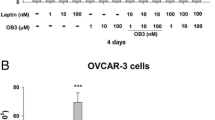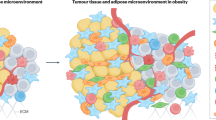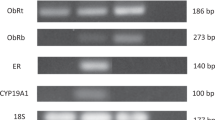Abstract
The association between obesity and cancer is controversial: whereas several epidemiological, clinical and research studies using cancer cell lines have supported that high levels of insulin and leptin could favor prostate cancer development and dissemination, other studies have demonstrated opposite effects or even absence of association. The main goal of this study was to evaluate the in vitro proliferation of murine androgen insensitive prostate carcinoma cells RM1 in the presence of leptin and insulin. After assessing and confirming the presence of leptin and insulin receptors in RM1 cells by immunocytochemistry, cells were cultured in the presence of different concentrations of leptin (0, 25, 50, 100 and 200 ng/mL), insulin (0, 50, 100, 150 and 200 nM) or leptin plus insulin ( 25 ng/ml + 50 nM; 50 ng/ml + 100 nM; 100 ng/ml + 150 nM; 200 ng/ml + 200 nM; 25 ng/ml + 150 nM; 100 ng/ml + 50 nM of leptin plus insulin, respectively). Cell proliferation was evaluated by assessing the percentage of resazurin reduction, a surrogate marker of cell metabolic rate. Leptin significantly decreased the percentage of resazurin reduction in all studied concentrations while there was only a slight or non significant difference in RM1cell proliferation in the presence of insulin or insulin combined with leptin when compared with control. These results show that leptin decreases RM1 prostate cancer cell proliferation at the studied concentrations, while insulin is able to antagonize the leptin inhibition of RM1 prostate cancer cell growth in vitro. The difference in cell growth that is modulated by the various hormonal environments may explain the heterogeneous behavior of prostate cancer in the obese human population.





Similar content being viewed by others
Abbreviations
- ICC:
-
Immunocytochemistry
- TNF-α:
-
Tumor necrosis factor
- IL-6:
-
Interleucine-6
- VEGF:
-
Endothelial vascular growing factor
- ObR:
-
Leptin receptor
- ObRa:
-
Leptin receptor short isoform
- ObRb:
-
Leptin receptor long isoform
- Ras/ERK1/2:
-
Ras/extracellular signal – regulated kinases 1/2
- JAK2 / STAT3:
-
Janus kinase 2 / signal transducer and activator of transcription 3
- PI-3K / Akt / GSK 3:
-
Phosphoinositite 3 kinase / protein kinase B / glycogen synthesis kinase 3
- RAS/RAF/MEK/ERK:
-
Ras/Raf/ mitogen-activated protein kinase/ extracellular-signal-regulated kinase pathway
- Akt/PI-3K:
-
Protein kinase B/Phosphatidylinositol 3-kinases
- IGF-1:
-
Insulin-like growth factor-1
- DIO:
-
Diet induced obesity mice
- SEM:
-
Standard error of the mean
References
Kumar RJ, Barqawi AB, Craw ED (2008) Epidemiology of Prostate Cancer. US Oncology Review 2005
Schaid DJ (2004) The complex genetic epidemiology of prostate cancer. Hum Mol Genet 13(1):103–121
Mukherjee P, Sotnikov AV, Mangian HJ et al (1999) Energy intake and prostate tumor growth, angiogenesis, and vascular endothelial growth factor expression. J Natl Cancer Inst 91(6):512–523
Bosland MC, Oakley-Girvan I, Whittemore AS (1999) Dietary fat, calories, and prostate cancer risk. J Natl Cancer Inst 91(6):489–491
Friedenreich CM, Orenstein MR (2002) Physical activity and cancer prevention: etiologic evidence and biological mechanisms. J Nutr 132(11 Suppl):3456S–3464S
Calle EE, Kaaks R (2004) Overweight, obesity and cancer: epidemiological evidence and proposed mechanisms. Nat Rev Cancer 4(8):579–591
Crespo CJ, Smit E, Troiano RP et al (2001) Television watching, energy intake, and obesity in US children: results from the third National Health and Nutrition Examination Survey, 1988–1994. Arch Pediatr Adolesc Med 155(3):360–365
Stubbs CO, Lee AJ (2004) The obesity epidemic: both energy intake and physical activity contribute. Med J Aust 181(9):489–491
Mistry T, Digby JE, Desai KM et al (2007) Obesity and prostate cancer: a role for adipokines. Eur Urol 52(1):46–53
Garg A (2006) Adipose tissue dysfunction in obesity and lipodystrophy. Clin Cornerstone 8(Suppl 4):S7–S13
Trayhurn P, Beattie JH (2001) Physiological role of adipose tissue: white adipose tissue as an endocrine and secretory organ. Proc Nutr Soc 60(3):329–339
Kershaw EE, Flier JS (2004) Adipose tissue as an endocrine organ. J Clin Endocrinol Metab 89(6):2548–2556
Ronti T, Lupattelli G, Mannarino E (2006) The endocrine function of adipose tissue: an update. Clin Endocrinol (Oxf) 64(4):355–365
Wajchenberg BL (2000) Subcutaneous and visceral adipose tissue: their relation to the metabolic syndrome. Endocr Rev 21(6):697–738
Haque WA, Garg A (2004) Adipocyte biology and adipocytokines. Clin Lab Med 24(1):217–234
Tilg H, Moschen AR (2006) Adipocytokines: mediators linking adipose tissue, inflammation and immunity. Nat Rev Immunol 6(10):772–783
Badman MK, Flier JS (2007) The adipocyte as an active participant in energy balance and metabolism. Gastroenterology 132(6):2103–2115
Zhang Y, Proenca R, Maffei M et al (1994) Positional cloning of the mouse obese gene and its human homologue. Nature 372(6505):425–432
Frederich RC, Hamann A, Anderson S et al (1995) Leptin levels reflect body lipid content in mice: evidence for diet-induced resistance to leptin action. Nat Med 1(12):1311–1314
Boden G, Chen X, Mozzoli M et al (1996) Effect of fasting on serum leptin in normal human subjects. J Clin Endocrinol Metab 81(9):3419–3423
Bjorbaek C, Uotani S, da Silva B et al (1997) Divergent signaling capacities of the long and short isoforms of the leptin receptor. J Biol Chem 272(51):32686–32695
Tartaglia LA (1997) The leptin receptor. J Biol Chem 272(10):6093–6096
Hoggard N, Hunter L, Duncan JS et al (1997) Leptin and leptin receptor mRNA and protein expression in the murine fetus and placenta. Proc Natl Acad Sci U S A 94(20):11073–11078
Bailleul B, Akerblom I, Strosberg AD (1997) The leptin receptor promoter controls expression of a second distinct protein. Nucleic Acids Res 25(14):2752–2758
Somasundar P, Frankenberry KA, Skinner H et al (2004) Prostate cancer cell proliferation is influenced by leptin. J Surg Res 118(1):71–82
Banting FG (1926) An Address on Diabetes and Insulin: Being The Nobel Lecture Delivered at Stockholm on September 15th, 1925. Can Med Assoc J 16(3):221–232
Karam JH, Grodsky GM, Forsham PH (1968) Insulin secretion in obesity: pseudodiabetes? Am J Clin Nutr 21(12):1445–1454
Kahn BB, Flier JS (2000) Obesity and insulin resistance. J Clin Invest 106(4):473–481
Cox ME, Gleave ME, Zakikhani M et al (2009) Insulin receptor expression by human prostate cancers. Prostate 69(1):33–40
Cullen KJ, Yee D, Sly WS et al (1990) Insulin-like growth factor receptor expression and function in human breast cancer. Cancer Res 50(1):48–53
Frasca F, Pandini G, Sciacca L et al (2008) The role of insulin receptors and IGF-I receptors in cancer and other diseases. Arch Physiol Biochem 114(1):23–37
Baillargeon J, Rose DP (2006) Obesity, adipokines, and prostate cancer (review). Int J Oncol 28(3):737–745
Danforth KN, Rodriguez C, Hayes RB et al (2008) TNF polymorphisms and prostate cancer risk. Prostate 68(4):400–407
Ribeiro AM, Andrade S, Pinho F et al (2010) Prostate cancer cell proliferation and angiogenesis in different obese mice models. Int J Exp Pathol 91(4):374–386
Baley PA, Yoshida K, Qian W et al (1995) Progression to androgen insensitivity in a novel in vitro mouse model for prostate cancer. J Steroid Biochem Mol Biol 52(5):403–413
Freedland SJ, Giovannucci E, Platz EA (2006) Are findings from studies of obesity and prostate cancer really in conflict? Cancer Causes Control 17(1):5–9
Giovannucci E, Rimm EB, Liu Y et al (2003) Body mass index and risk of prostate cancer in U.S. health professionals. J Natl Cancer Inst 95(16):1240–1244
Malendowicz W, Rucinski M, Macchi C et al (2006) Leptin and leptin receptors in the prostate and seminal vesicles of the adult rat. Int J Mol Med 18(4):615–618
Hoda MR, Popken G (2008) Mitogenic and anti-apoptotic actions of adipocyte-derived hormone leptin in prostate cancer cells. BJU Int 102(3):383–388
Deo DD, Rao AP, Bose SS et al (2008) Differential effects of leptin on the invasive potential of androgen-dependent and -independent prostate carcinoma cells. J Biomed Biotechnol 2008:163902
Hsing AW, Chua S Jr, Gao YT et al (2001) Prostate cancer risk and serum levels of insulin and leptin: a population-based study. J Natl Cancer Inst 93(10):783–789
Kelly T, Yang W, Chen CS et al (2008) Global burden of obesity in 2005 and projections to 2030. Int J Obes (Lond) 32(9):1431–1437
Farooqi IS, O’Rahilly S (2009) Leptin: a pivotal regulator of human energy homeostasis. Am J Clin Nutr 89(3):980S–984S
Belkina AC, Denis GV (2010) Obesity genes and insulin resistance. Curr Opin Endocrinol Diabetes Obes 17(5):472–477
Muoio DM, Newgard CB (2008) Mechanisms of disease: molecular and metabolic mechanisms of insulin resistance and beta-cell failure in type 2 diabetes. Nat Rev Mol Cell Biol 9(3):193–205
Wotton CJ, Yeates DG, Goldacre MJ (2011) Cancer in patients admitted to hospital with diabetes mellitus aged 30 years and over: record linkage studies. Diabetologia 54(3):527–534
Polednak AP, Phillips CE (2010) Obtaining data on comorbid diabetes among patients in a U.S. population-based tumor registry. J Registry Manag 37(2):57–64
Acknowledgment
We thank Prof Thompson from MD Anderson Cancer Center for kindly providing the RM1 cells that made this work possible; Rui Medeiros, Ricardo Ribeiro for support with cell culture.
UMIB is funded by grants from Foundation for Science and Technology (FCT) POCTI/FEDER Portugal.
Author information
Authors and Affiliations
Corresponding author
Rights and permissions
About this article
Cite this article
Ribeiro, A.M., Pereira, S., Andrade, S. et al. Insulin Prevents Leptin Inhibition of RM1 Prostate Cancer Cell Growth. Pathol. Oncol. Res. 18, 499–507 (2012). https://doi.org/10.1007/s12253-011-9473-9
Received:
Accepted:
Published:
Issue Date:
DOI: https://doi.org/10.1007/s12253-011-9473-9




